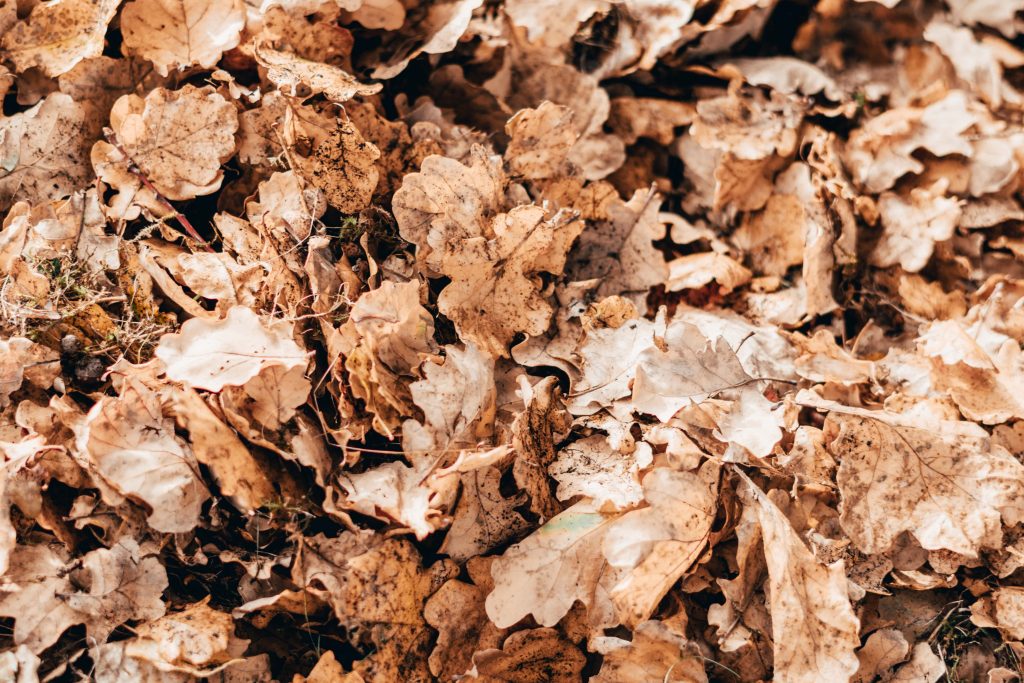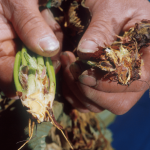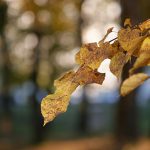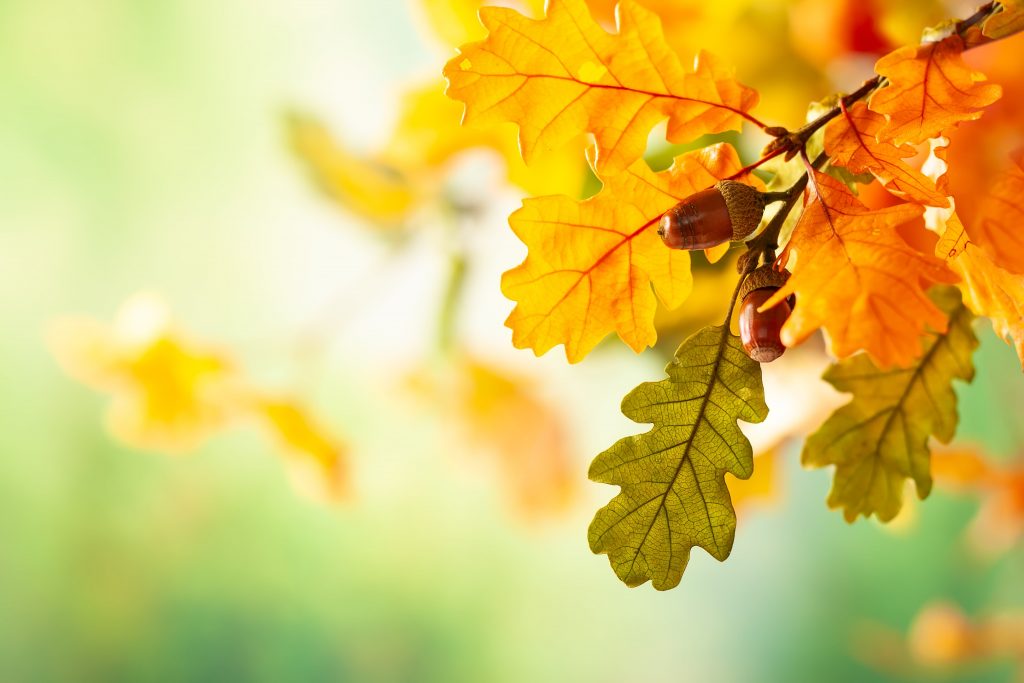
Learn how to identify the difference between Oak Wilt and the normal beautiful autumn color of Oak Trees in Illinois.
We are back this week with our series on the common tree diseases and insect pests in Illinois with a close look at a serious disease that threatens all types of oak trees; oak wilt. Oak wilt is a dangerous vascular wilt disease caused by the fungus Bretziella fagacearum that oak trees can contract over land or through their roots. The main symptoms of oak wilt include discoloration and wilting of the leaves and defoliation, and it can kill some species of oak within weeks or months of infection. It is very important to prevent oak wilt and control outbreaks because there is no cure for it.
Oak wilt was first discovered in the 1940s in Wisconsin and it has since spread through much of the eastern U.S. from Michigan down the Appalachian Mountains to Georgia, and from Minnesota down to Texas. Illinois is one of the states where oak wilt can be found, making it important for those who have oak trees on their property to watch for signs of the disease. Red oak tree species, including red oaks, black oaks, and scarlet oaks are the most vulnerable to the disease while white oak tree species, including white oaks, bur oaks, and English oaks are more resistant and may even recover within a year of infection.
In this guide, we will discuss the life cycle of oak wilt, the main symptoms of the disease, and the most effective ways to treat and manage the disease. Our arborists at Hendricksen Tree Care understand the danger that oak wilt poses to the oak tree population and we provide tree care and maintenance services to help prevent and manage oak wilt disease. We will help prevent oak wilt by ensuring that your oak trees receive the proper care and fertilization so they can better resist the disease. We can also provide effective tree pruning to help limit the spread of the disease once your trees become infected. Make sure you contact us immediately if your oak trees are showing signs of oak wilt so we can come up with a solution to manage the disease.
Oak Wilt Life Cycle
Oak wilt is a vascular wilt disease and like with all types of vascular wilts, the fungus itself does not cause the death of the tree. Once the fungus enters the sapwood of the oak tree, the tree reacts by trapping the fungus where it is, causing a disruption to the flow of water upward towards the branches and leaves. This is what causes the wilting of the leaves and branches which eventually leads to defoliation and dieback. Killing the disease-causing fungus is not as effective for managing oak wilt as keeping the flow of water to the canopy open.
Which Trees are Susceptible?
Oak wilt can infect any species of oak, but it mainly affects red oak and white oak species. Red oak species are much more vulnerable to oak wilt and will die faster than white oak species when infected. One of the reasons red oak species die quickly from oak wilt is because red oak trees form spore mats, which are the fruiting bodies of the fungus that causes oak wilt. These spore mats can easily spread the disease to new trees overland which makes this disease very dangerous if it attacks a group of red oak trees. Oak wilt can kill red oaks in just a few weeks or months as it causes the leaves to become wilted and the branches to die from the top to the bottom of the tree.
White oaks can live much longer after becoming infected with oak wilt, some as long as several years. Infected white oaks will typically lose a few branches each growing season starting at the top of the tree. After a season or two, infected white oaks will show dead crowns in contrast to their green canopies that have not been affected yet.
Oak Wilt Disease Transmission
As mentioned above, oak wilt is caused by the fungus Bretziella fagacearum. The following are the two main ways that oak trees can contract this fungus:
- Overland: Overland transmission is when trees are exposed to the fungus through the air. This usually happens when the spores of the fungus travel through wind or water, or when insects, birds, and other animals bring the spores to the tree. Animals such as insects, birds, and small mammals are attracted to the spore mats on already infected oak trees because they have a fruity smell. These animals will then pick up the spores and deposit them in the wounds of healthy oak trees. This is why it is important to look for and seal any wounds on your oaks during the growing season.
- Underground: Oak wilt can move between oak trees underground through root grafts. Root grafts occur when the roots of two different trees become interconnected underground. This is the most common way that oak wilt spreads as root grafting accounts for around 85 percent of new oak wilt cases. Root grafts can occur between oak trees that are 50 to 150 feet away from each other. Once the fungus travels to the new tree through root grafts, it travels through the xylem, or vascular tissue in the wood. Root grafts typically happen between similar species of oak that are of the same generation. Root grafts between old and young trees are rare, as are root grafts between red and white oak species.
Life Cycle of Oak Wilt Fungus
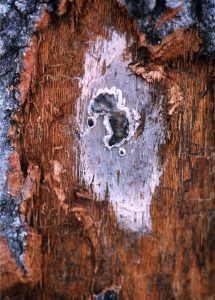
If your Oak Tree has a spore mat formation the tree is dead and should be removed immediately to prevent the spread of Oak Wilt. Photo courtesy of wikipedia.org
The life cycle of the Bretziella fagacearum fungus is basically the same in red oaks and white oaks, but it works much faster on red oak trees. The following are the stages of oak wilt:
- Stage I: In this stage, the fungus has found its way into the vascular system and the tree has cornered it, disrupting the flow of water to the leaves and branches. The leaves will first start to turn bronze and then brown as they begin wilting. Defoliation and dieback of the branches will follow. These symptoms usually start to show in the spring and can continue into the summer.
- Stage II: During this stage, the vascular tissues may have brown streaks or spots that can be seen under the bark. This usually happens within a month or two of infection.
- Stage III: In this stage, the tree is dead and spore mats have started to form underneath the bark. As the spore mats grow, they eventually break through the bark and attract insects and other animals that pick up the spores. These animals, as well as wind and water, can transfer the fungus to a new tree. The formation of spore mats typically happens in the early spring or late fall the year after the infection for red oak trees. Some red oaks never form these spore mats.
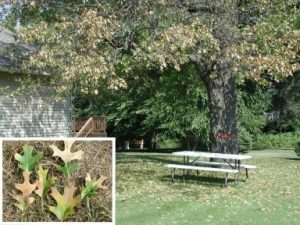
Symptoms of Oak Wilt include browning & wilting of leaves, followed by sudden leaf drop. Photo by Joseph O’Brien, USDA Forest Service, Bugwood.org
Symptoms of Oak Wilt
As described above, red oak trees and white oak trees react a little differently to oak wilt, even though the disease is the same. In both trees, the fungus attacks the xylem and the tree defends itself by blocking off the fungus to prevent it from spreading. This in turn disrupts the flow of water to the branches and leaves which causes the symptoms associated with oak wilt.
Symptoms in Red Oaks
Red oak trees are hit the hardest by oak wilt and experience the symptoms very quickly. If a red oak tree is infected early in the growing season, it will start showing signs within a couple of weeks. The first sign of oak wilt is discoloration of the leaves as they turn a bronze color and then brown. The leaves will start to wilt as they become discolored and fall off the tree prematurely. Complete defoliation can occur by mid-summer.
Other symptoms include suckering at the base of the tree and brown streaks in the sapwood under the bark. Infected red oak trees are likely to die by the end of the summer and they will form spore mats the following growing season.
Symptoms in White Oaks
White oak trees experience the same symptoms from oak wilt as red oaks, but the symptoms can be stretched out over several years. Discoloration and wilting of the leaves will occur on white oaks, but it will happen on a couple of branches at a time, making the infection appear localized. A couple branches per year may be affected and complete defoliation never occurs. After a couple of years, individual branches will become defoliated, making the top of the crown appear dead while the branches around the affected area appear to be healthy. It is also very rare for white oaks to form spore mats.
Oak Wilt Control
If you believe your oak trees are affected by oak wilt, you need to call a professional arborist to inspect the tree. The symptoms of oak wilt are similar to those of other diseases and pest infestations, so your tree needs to be tested to know for sure if it is infected with oak wilt.
If your trees are affected by oak wilt, the following measures can help control the disease:
- Cover wounds: Open wounds on the branches and bark of oak trees leave them highly susceptible to contracting the fungus. If you notice any wounds on your oak trees, cover them immediately with non-toxic tree wound dressing, especially if they occur between April and October.
- Limit pruning: Pruning can create wounds that attract insects that can transmit the disease. You should only prune your oak trees between November 1 and April 1 and make sure you sterilize the tools before each cut. The insects that can spread oak wilt are the most active between April and October so do not prune your oak trees during these months.
- Treat root grafts: Severing root grafts between oak trees can slow the spread of oak wilt as this is the most common way the disease spreads. However, this is a dangerous and difficult job that is best handled by a professional arborist. These professionals will sever root grafts using mechanical barriers or chemical barriers.
- Remove infected trees and wood: When an oak tree is heavily infected or killed by oak wilt, it needs to be removed before the following growing season to prevent it from forming spore mats. You should also avoid using and transporting infected logs from red oaks unless the bark has been removed. Wood from white oaks is safe because they do not form spore mats.
- Fungicides: There are fungicide injections that can help control the symptoms of oak wilt, but it is best to have a professional arborist administer these treatments.
Tree Care and Maintenance from Hendricksen Tree Care
If there are oak trees in your yard, whether they are white oak or red oak species, you need to take preventative measures to protect them from oak wilt. Once oak wilt occurs, it can cause severe damage and death very quickly in red oaks and spread between oak trees. If you notice any signs of oak wilt, call a professional arborist right away to diagnose the problem and provide solutions to manage it.
Hendricksen Tree Care takes the health of your trees seriously and we can help diagnose and control oak wilt. We will test your trees to confirm the diagnosis of oak wilt and discuss your options with you when it comes to treatment and management. The treatment options we discuss with you will be practical based on the condition of your trees and within your budget. If your tree is heavily infected, we can provide tree removal to take down the oak before it has a chance to form spore mats and spread the disease. Our arborists are available to treat and manage oak trees affected by oak wilt in Arlington Heights, Highland Park, Park Ridge, Barrington, Palatine, Lake Zurich, Northbrook, Glenview, Wilmette, and the surrounding areas in the north and northwest Chicago suburbs.
Look out for the next blog in our series about the common tree diseases and insect pests in the Chicago, IL area.
